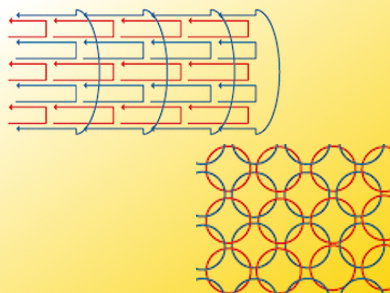DNA Bundles Transform into Stable Chain-Armor-Like Nanostructures
Short single strands of DNA can self-assemble to create DNA nanostructures. Scientists based in Munich, Germany, have prepared not only assembled, but even catenated oligonucleotide structures to form chain-armor DNA nanotubes that withstand high temperatures, and chemical and enzymatic attacks. As they report in the journal Angewandte Chemie, they used effective click chemistry to prepare the DNA catenane rings.
Catenanes are intertwined rings that form stable structures – like the small metal rings in chain mail armor. In nature, catenated DNA is found in the form of kinetoplast DNA from parasites of the species Trypanosoma. Antonio Manetto and his team at Baseclick GmbH, Germany, in cooperation with teams at the Universities of Munich and Nuremberg as well as Aarhus University, explored DNA origami and single-stranded tile techniques to assemble a 6-helix bundle from 24 oligonucleotides.
Copper-Catalyzed Azide–Alkyne Click Chemistry
Some of the oligonucleotide tiles were furnished with the end groups used for effective copper(I)-catalyzed click chemistry: azide and alkyne groups. The subsequent click reaction connected the groups and locked the oligonucleotide to a ring. The structural organization of the tiles in the helix bundle affected the formation of catenanes, which stabilized the whole nanostructure like the metal rings in the chain mail.
The catenanes exhibited superior stability to the original assembled structure as they clearly resisted the thermal and even chemical or exonuclease attacks. Therefore, Manetto and his colleagues went on to introduce catenanes into the helix bundle until all 24 oligonucleotides were eventually catenated. Their efforts led to DNA chain armor that had considerably higher melting temperature than previous structures.
Stabilized DNA nanostructures like this can serve several purposes. Possible applications range from electronics and nanooptics to nanomedicine and diagnostics, and stable DNA containers can be used for drug delivery. The new method makes it relatively simple to access these structures. The authors summarize: “The method is not limited to the production of DNA catenanes of varying sizes and chain geometries but could be further applied to assemble oligonucleotides for the synthesis of long single-stranded DNA, thus paving the way to a non-enzymatic approach to gene synthesis.”
- One-Step Formation of “Chain-Armor”-Stabilized DNA Nanostructures,
Valentina Cassinelli, Birgit Oberleitner, Jessica Sobotta, Philipp Nickels, Guido Grossi, Susanne Kempter, Thomas Frischmuth, Tim Liedl, Antonio Manetto,
Angew. Chem. Int. Ed. 2015.
DOI: 10.1002/anie.201500561




